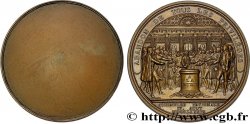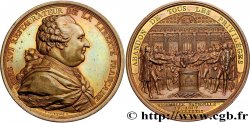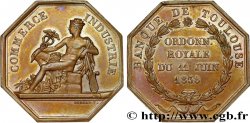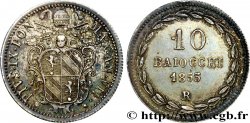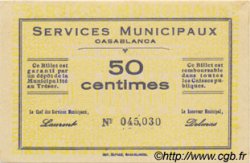Live auction - fme_923445 - LOUIS XVI Médaille, Canal du Centre
You must signin and be an approved bidder to bid, LOGIN TO BID. Accounts are subject to approval and the approval process takes place within 48 hours. Do not wait until the day a sale closes to register. Clicking on "BID" constitutes acceptance of the terms of use of cgb.fr private live auctions.
Bids must be placed in whole Euro amounts only. The sale will start closing at the time stated on the item description; any bids received at the site after the closing time will not be executed. Transmission times may vary and bids could be rejected if you wait until the last second. For further information check the Live auction FAQ
All winning bids are subject to a 18% buyer’s fee.
All winning bids are subject to a 18% buyer’s fee.
| Estimate : | 120 € |
| Price : | 62 € |
| Maximum bid : | 65 € |
| End of the sale : | 09 July 2024 17:23:10 |
| bidders : | 2 bidders |
Type : Médaille, Canal du Centre
Date: 1783
Metal : copper
Diameter : 50 mm
Orientation dies : 12 h.
Engraver DUVIVIER Benjamin (1730-1819)
Weight : 61,29 g.
Edge : lisse
Puncheon : sans poinçon
Coments on the condition:
Patine marron hétérogène présentant quelques coups et rayures, notamment sur la tranche. Restes de brillant de frappe au revers
Obverse
Obverse legend : LUDOVICO XVI. FR. ET NAVAR. REGI OPTIMO // À L’EXERGUE : COMITIA BURGUNDIAE.
Obverse description : Buste habillé et drapé de louis XVI à droite. Signé sous le buste : DU VIVIER.
Reverse
Reverse legend : UTRIUSQUE MARIS JUNCTIO TRIPLEX // À L’EXERGUE : FOSSIS AB ARARI / AD LIGERIM SEQUANAM ET RHENUM / SIMUL APERTIS / MDCCLXXXIII.
Reverse description : La Bourgogne personnifiée assise avec une corne d’abondance et de bouclier à ses pieds, tenant un caducée de la main droite ; autour d’elle les dieux fleuves du Rhin, de la Saône et de la Loire. Signé à l’exergue : DU VIVIER.
Commentary
Le canal du Centre relie les vallées de la Loire et de la Saône. Le canal est également connu comme canal du Charolais.
La Dheune, affluent de la Saône, et la Bourbince, affluent de la Loire, ont depuis longtemps (XVe-XVIe siècles) retenu l'attention des ingénieurs par l'orientation de leurs cours qui permettaient d'envisager une liaison entre le sillon rhodanien et la Méditerranée d'une part, et l'Atlantique ou la Manche, la Loire étant elle-même reliée à la Seine depuis 1642 par le canal de Briare. Le projet soutenu par l'ingénieur Thomassin est d'abord en concurrence avec le canal de Bourgogne mais les deux canaux seront finalement réalisés.Le grand artisan du canal du Centre est Émiland Gauthey (1732-1806), ingénieur des États de Bourgogne : son projet élaboré et modifié pendant plusieurs années est approuvé en 1782 par le Parlement de Bourgogne et réalisé de 1784 à 1791/1793 sous son autorité. Appelé à l'origine « canal du Charolais », l'ouvrage, alimenté par les étangs et les divers cours d'eau des bassins versants, comprend un canal latéral à la Bourbince de Digoin à Montceau-les-Mines, un canal à bief de partage de Montceau à Saint-Julien-sur-Dheune, un canal latéral à la Dheune de Saint-Julien à Chagny, un canal de jonction par dérivation de la Dheune vers la Thalie par la tranchée de Chagny à Rully et un canal latéral à la Thalie de Rully à Chalon-sur-Saône. À l'initiative d’Émiland Gauthey, on a préféré le tracé le plus court en ne suivant pas le cours inférieur de la Dheune : celui-ci manquait de profondeur et présentait de grandes variations de débit (sécheresse et inondations) avec de nombreux méandres et parfois plusieurs bras, de plus la rivière n'aboutissait pas à un port.
La Dheune, affluent de la Saône, et la Bourbince, affluent de la Loire, ont depuis longtemps (XVe-XVIe siècles) retenu l'attention des ingénieurs par l'orientation de leurs cours qui permettaient d'envisager une liaison entre le sillon rhodanien et la Méditerranée d'une part, et l'Atlantique ou la Manche, la Loire étant elle-même reliée à la Seine depuis 1642 par le canal de Briare. Le projet soutenu par l'ingénieur Thomassin est d'abord en concurrence avec le canal de Bourgogne mais les deux canaux seront finalement réalisés.Le grand artisan du canal du Centre est Émiland Gauthey (1732-1806), ingénieur des États de Bourgogne : son projet élaboré et modifié pendant plusieurs années est approuvé en 1782 par le Parlement de Bourgogne et réalisé de 1784 à 1791/1793 sous son autorité. Appelé à l'origine « canal du Charolais », l'ouvrage, alimenté par les étangs et les divers cours d'eau des bassins versants, comprend un canal latéral à la Bourbince de Digoin à Montceau-les-Mines, un canal à bief de partage de Montceau à Saint-Julien-sur-Dheune, un canal latéral à la Dheune de Saint-Julien à Chagny, un canal de jonction par dérivation de la Dheune vers la Thalie par la tranchée de Chagny à Rully et un canal latéral à la Thalie de Rully à Chalon-sur-Saône. À l'initiative d’Émiland Gauthey, on a préféré le tracé le plus court en ne suivant pas le cours inférieur de la Dheune : celui-ci manquait de profondeur et présentait de grandes variations de débit (sécheresse et inondations) avec de nombreux méandres et parfois plusieurs bras, de plus la rivière n'aboutissait pas à un port.








 Report a mistake
Report a mistake Print the page
Print the page Share my selection
Share my selection Ask a question
Ask a question Consign / sell
Consign / sell
 Full data
Full data